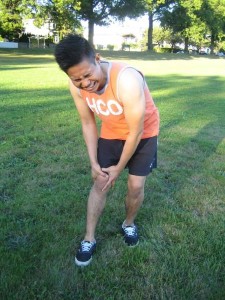Bursitis refers to a painful condition in which the bursae become inflamed. Bursae are small fluid-filled sacs that pad the bones, tendons and muscles that are near your joints.
Bursitis commonly affects the elbow, shoulder and hip. However, bursitis may also occur in the heel, base of the big toe and the knee. Bursitis commonly occurs in joints that are susceptible to repetitive motion.
Treatment mainly involves resting the affected region or joint and protecting it from further injury. Many people tend to recover from bursitis within a few weeks of proper treatment. However, recurrent bouts or attacks are common as well.

Signs and symptoms
Signs and symptoms of bursitis include:
- Achiness or stiffness of the joint
- Increasing pain due to movement or pressure (by pressing, for example)
- Red and swollen appearance of the affected area
When to seek medical attention
See a health care provider if you experience the following:
- Disabling pain in the joint
- Persistent pain – lasts for more than 1-2 weeks
- Excessive sweating from the affected region
- Bruising, rashes or swelling of the affected area
- Fever
Causes
Bursitis is commonly caused due to repetitive motions or postures that may irritate and inflame the bursae around a joint. Common causes may include:
- Flinging something such as throwing a baseball over your head repeatedly
- Extensive kneeling for daily tasks such as scrubbing the floors
- Leaning on your elbows for prolonged periods
- Prolonged sitting, especially on hard surfaces
Treatment
Treatment for bursitis often involves conservative methods such as rest, ice, compress, elevate and the usage of pain relievers as initial steps. If conservative methods are ineffective, your doctor may proceed with the following treatments:
- Medication. If inflammation is caused due to an infection, your health care provider may prescribe antibiotics
- Physical therapy. Your doctor may advise physical therapy or rehabilitation exercises in order to strengthen the muscles and allow them to function properly. This will also relieve pain and prevent re-injury
- Corticosteroid injections. Corticosteroid drugs will be injected into the bursa to reduce inflammation
- Surgery. In some cases, the bursae may have to be drained surgically, however, this treatment method is required very rarely
Home care treatment
The following measures will help improve symptoms such as pain and swelling at home:
- Resting and immobilizing the affected joint
- Applying ice to the affected joint to reduce pain and swelling
- Over-the-counter pain medication such as ibuprofen or naproxen to reduce pain and inflammation
- Cushioning the knees by placing a small pillow or cushion between the legs, in case you sleep on your side
- Avoiding elbow pressure by not leaning or applying pressure to the elbow while resting, or rising from a lying position
Related Articles you May Also Enjoy
- How to prevent disease transmission when providing first aid – Read Here
- Ear Infections: Complications and Management – Read Here
